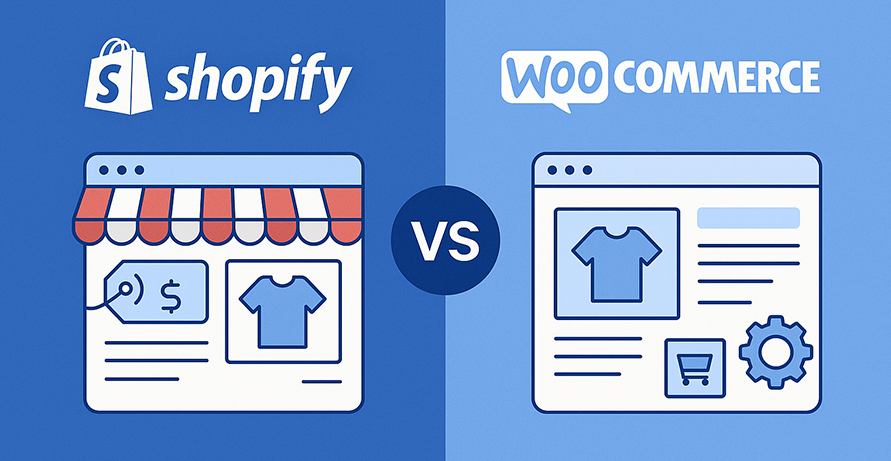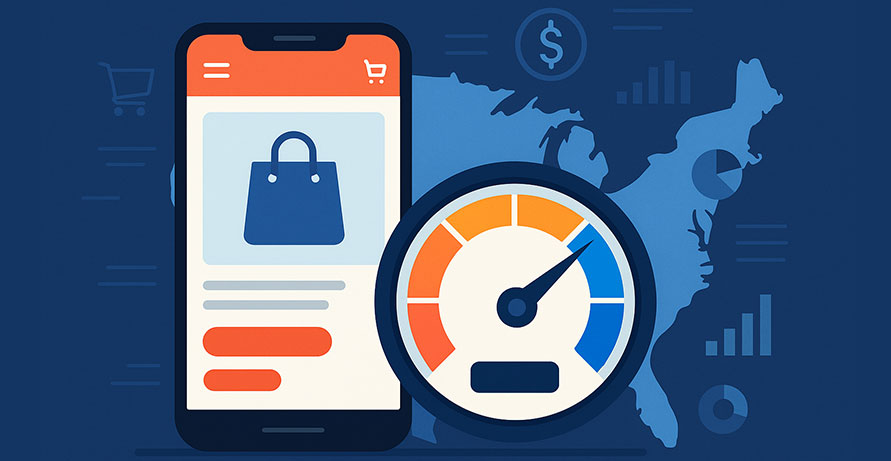Choosing Between Shopify and WooCommerce: What’s Right for You?

For businesses entering or expanding in the e-commerce space, one of the most important decisions is selecting the right platform. Shopify and WooCommerce are two of the most popular options for online stores, each offering unique advantages in cost, flexibility, scalability, and ease of use. Choosing incorrectly can limit your store’s growth and increase long-term expenses.
This blog compares Shopify and WooCommerce in depth, covering setup, customization, scalability, pricing, and support. It also highlights how Anchor Points helps U.S. businesses design and manage successful e-commerce stores that maximize performance and profit.
Why the Right E-Commerce Platform Matters
E-commerce in the U.S. is expected to surpass 1.6 trillion dollars by 2027 (Statista, 2025). With this surge, small and mid-sized businesses are under pressure to launch fast, scale quickly, and deliver seamless shopping experiences.
Choosing between Shopify and WooCommerce directly impacts how your business grows. It determines how quickly you can launch and update your store, how flexible your customization options are, how much you spend on hosting and maintenance, and how your website performs during high-traffic periods.
Author’s Expert Viewpoint:
At Anchor Points we’ve built and managed both Shopify and WooCommerce stores. The right platform depends not just on your budget but on your long-term business vision.
Shopify: Simplicity and Speed for Growing Businesses
Shopify is a hosted e-commerce platform that offers everything you need to run a store — from hosting and design to payment gateways and security. It is a fully managed solution ideal for entrepreneurs who value simplicity and speed over technical complexity.
Shopify’s key strengths include easy setup, integrated hosting, and built-in security features such as PCI DSS compliance and SSL encryption. With thousands of apps available, businesses can add functionalities like inventory management, marketing automation, and advanced analytics without technical expertise.
A real-world example comes from a fashion brand in California that scaled from 50 to 5,000 daily visitors using Shopify Plus without managing a single server or plugin update.
However, Shopify does have some limitations. Monthly subscription fees increase as you scale, customization at the backend is limited, and transaction fees apply if you use non-Shopify payment gateways.
Anchor Points Integration:
We help brands optimize Shopify stores with custom themes, SEO setups, and API integrations. From landing pages to analytics dashboards, Anchor Points ensures stores stay scalable, conversion-ready, and visually aligned with brand goals.
Author’s Viewpoint:
Shopify is ideal for businesses that want to grow quickly with minimal technical setup. It works best for busy entrepreneurs who prefer managed simplicity.
WooCommerce: Flexibility and Control for Developers and Enterprises
WooCommerce, on the other hand, is an open-source WordPress plugin that turns your website into a powerful e-commerce store. It offers full control over every aspect of your store, from design and layout to hosting and backend configurations.
The platform’s main advantages include complete customization, ownership of all data, and the ability to integrate with any tool or API. It’s also more SEO-friendly thanks to its WordPress foundation, allowing better control over metadata, content, and structured data.
A U.S.-based electronics retailer leveraged WooCommerce to automate its entire workflow by integrating real-time inventory updates with its ERP system, successfully managing over 10,000 SKUs with zero manual intervention.
However, WooCommerce does require more technical management. You are responsible for hosting, backups, and security. Performance optimization and regular maintenance are critical to prevent issues, which may add to operational costs.
Anchor Points Integration:
Our WooCommerce experts build optimized stores with custom plugins, secure hosting, and integrated payment solutions. We also provide automated backups, PCI compliance, and performance tuning so businesses can scale confidently.
Author’s Viewpoint:
WooCommerce is perfect for businesses that prioritize flexibility, customization, and total control over their e-commerce environment.
Shopify vs WooCommerce: Key Differences Explained
When comparing Shopify and WooCommerce, the first major difference is setup time. Shopify allows you to launch your store almost instantly since everything — hosting, design, and security — is included in your plan. WooCommerce, however, requires initial setup for hosting, domain, and WordPress installation, which takes more effort but provides more control.
In terms of ease of use, Shopify is beginner-friendly with drag-and-drop tools. WooCommerce, while slightly more technical, rewards experienced users with deep customization.
Customization is another major difference. Shopify restricts backend code access, limiting complex changes. WooCommerce, being open-source, gives you full access to modify code, templates, and functionality to match your brand’s exact needs.
Cost structure also varies. Shopify operates on a monthly subscription model, while WooCommerce is free but requires hosting, plugins, and extensions. Shopify includes built-in hosting and 24/7 support, whereas WooCommerce relies on your hosting provider and community or managed support.
Author’s Viewpoint:
Shopify is like renting a space in a high-end shopping mall — convenient but with limitations. WooCommerce is like owning your own building — full freedom but more responsibility.
Cost Breakdown: Which One Is More Affordable?
The true cost of ownership depends on your business goals. Shopify’s plans start at 39 dollars per month, scaling up to 399 dollars for advanced features or custom enterprise pricing under Shopify Plus. Extra apps and transaction fees can add to the cost.
WooCommerce itself is free, but you’ll need to pay for hosting, premium plugins, and development support. A basic WooCommerce setup with professional hosting may cost around 50 to 100 dollars monthly.
For example, a U.S. boutique store managing 500 products paid roughly 150 dollars per month on Shopify, while the same setup on WooCommerce cost about 60 dollars but required technical maintenance.
Anchor Points Integration:
We help clients evaluate total cost of ownership for both platforms, ensuring they understand long-term hosting, scalability, and customization expenses.
Scalability and Growth Potential
Both Shopify and WooCommerce scale well, but they do so differently. Shopify handles growth through its managed cloud infrastructure and global CDN, making it ideal for businesses that experience rapid traffic surges.
WooCommerce, meanwhile, scales through customization and server optimization. With the right hosting and caching strategy, WooCommerce can support enterprise-level operations and complex integrations.
Anchor Points Integration:
We offer Shopify Plus optimization for enterprise clients and scalable WooCommerce hosting on AWS or DigitalOcean. Our goal is to ensure that your online store grows alongside your business without sacrificing performance or user experience.
Author’s Viewpoint:
Scalability should align with your business strategy. Shopify supports fast growth; WooCommerce empowers deep integration.
Which Platform Is Right for You?
The best platform depends on your business model, resources, and long-term vision.
If you are a startup or small business, Shopify is the clear winner. It’s easy to set up, has low technical requirements, and offers excellent reliability for businesses that want to focus on sales, not infrastructure.
If you are an enterprise or customization-focused business, WooCommerce provides full control and scalability. It is ideal for content-heavy stores, B2B commerce, or organizations that need complete ownership of their platform.
If your business relies heavily on subscriptions or recurring payments, Shopify’s built-in billing system offers more stability. However, if your brand prioritizes content marketing or SEO, WooCommerce’s integration with WordPress makes it the stronger choice.
Author’s Viewpoint:
Your ideal platform is the one that complements your workflow and supports your growth ambitions. Choose based on long-term flexibility, not just short-term cost.
Final Takeaways
Shopify and WooCommerce are both powerful e-commerce platforms, but they cater to different priorities. Shopify offers convenience, speed, and a fully managed system for rapid scaling. WooCommerce delivers flexibility, customization, and ownership for businesses seeking independence and control.
At Anchor Points, we help U.S. businesses build, migrate, and optimize e-commerce stores on both platforms. Whether you’re launching your first store or modernizing an existing one, we tailor solutions for growth, security, and long-term success.
Not sure which platform fits your business vision? Contact Anchor Points today for a free consultation and e-commerce platform audit.
FAQs
Q1. Can I migrate from Shopify to WooCommerce or vice versa?
Yes. Anchor Points offers smooth migration services ensuring no data loss or downtime.
Q2. Which platform offers better SEO?
WooCommerce provides more advanced SEO control, while Shopify’s tools are sufficient for most users.
Q3. Is Shopify better for small businesses?
Yes. It’s simple to use and requires no technical setup.
Q4. Is WooCommerce free to use?
The plugin is free, but you need to pay for hosting and premium features.
Q5. Can both platforms handle high traffic?
Yes. Shopify scales automatically, while WooCommerce depends on optimized hosting.








